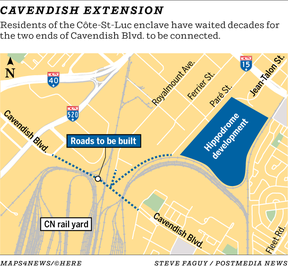Article content
The Namur-Hippodrome development will be a “city within a city,” complete with a transit project and thousands of social and affordable housing units, Montreal Mayor Valérie Plante pledges.
The city and province will make a major announcement at city hall Friday morning, and Plante couldn’t contain her excitement Thursday.
Article content
Speaking as a guest on the Gazette’s Corner Booth podcast, Plante said she will make the announcement about housing in the Namur-Hippodrome sector. It was the second time in as many days that she has teased this news. On Wednesday, she said the city will soon make an announcement of a social and affordable housing project with thousands of units.
Article content
Save for a two-night stint for U2 concerts in 2011, the land around the old Blue Bonnets racetrack has been abandoned since its last horse ran there in 2008. The land was sold to the province in the 1990s by former mayor Pierre Bourque and ceded back to the city under an agreement between the province and former mayor Denis Coderre. As part of the deal, the province stipulated the city must use the area for a housing development, with the first units built within five years, and that the city build the Cavendish Blvd. extension.

Plante said Cavendish is seen as an essential link to access a planned development at the Namur-Hippodrome sector, principally in the area of the old horse-racing track.
Speaking to podcast host Aaron Rand, who was accompanied by the Gazette’s Bill Brownstein and columnist and author Lesley Chesterman, Plante said she was able to get an agreement with private developers as well as the federal and provincial governments to develop the site and finance its construction.
She said Cavendish will play an essential role in the project, as it will be linked to Jean-Talon St. in the first phase. Planning by the city up to this point envisioned an electric tramway or other form of transit to shuttle residents to the Namur métro station. Plante said the goal is to build a new neighbourhood oriented around easy access to transit.
Article content
“We’re there,” she said. “Let’s say if we have 10,000 units, we can’t have 10,000 parking spots. Cities can’t be built this way anymore. So when we say ‘no cars,’ it’s to limit cars. I’m proud that when we announce a master plan, in creating this city within a city, it will be (in a coherent way).”
She pledged that the future development will be planned properly and have plenty of space for those who can’t afford exorbitant rents or luxury homes.
“Toronto and Vancouver have made it possible to build a lot, but it’s all for the same people with the same amount of money in their pocket,” Plante said. “I want to make sure there is affordable housing for the middle class, and social housing as well.
“Cavendish will happen, and there are different phases, but the first phase is: How do we bring public transit?”
She said the first step is to extend Jean-Talon through the development and connect it to the north end at Cavendish Blvd. However, she said it’s also essential to extend the south end, at the extremity of Côte-St-Luc.
Plante said the city still has to negotiate with the landowners in the area, specifically CP, which owns a railyard reserved for the southern part of the extension. She said it’s not clear if the boulevard will pass over or underneath the CP yard.
Côte-St-Luc Mayor Mitchell Brownstein said Thursday he was pleased there seems to be some movement on the long-delayed project.
“It’s good that they’re building housing and starting to work on Cavendish,” he said. “I’d like to see an exact timeline on when the project will connect in Côte-St-Luc, but the project still has not gone to the Bureau d’audiences publiques sur l’environnement to be studied, and we don’t understand why. Until that happens, we can’t know when the project will go ahead.”
Recommended from Editorial
Share this article in your social network





